Spring training was the best time for teammates to get to know Ted Williams. The games didn’t count, there was plenty of free time, and when he spent spring training in Sarasota, FL, there was great fishing nearby. Ted was much more approachable in March than he was during the regular season!
When nineteen-year-old Ted Williams arrived at his first spring training camp in Sarasota, Florida, Bobby Doerr took him to the Red Sox clubhouse to meet manager Joe Cronin. “I remember it like it was yesterday,” Hall of Famer Doerr recalled from his Oregon home in a 2012 interview, “I introduced him and Ted’s greeting to Cronin was, ‘Hi, sport!’ I think I knew at that moment that Ted would spend the 1938 season at Triple-A in Minneapolis.” 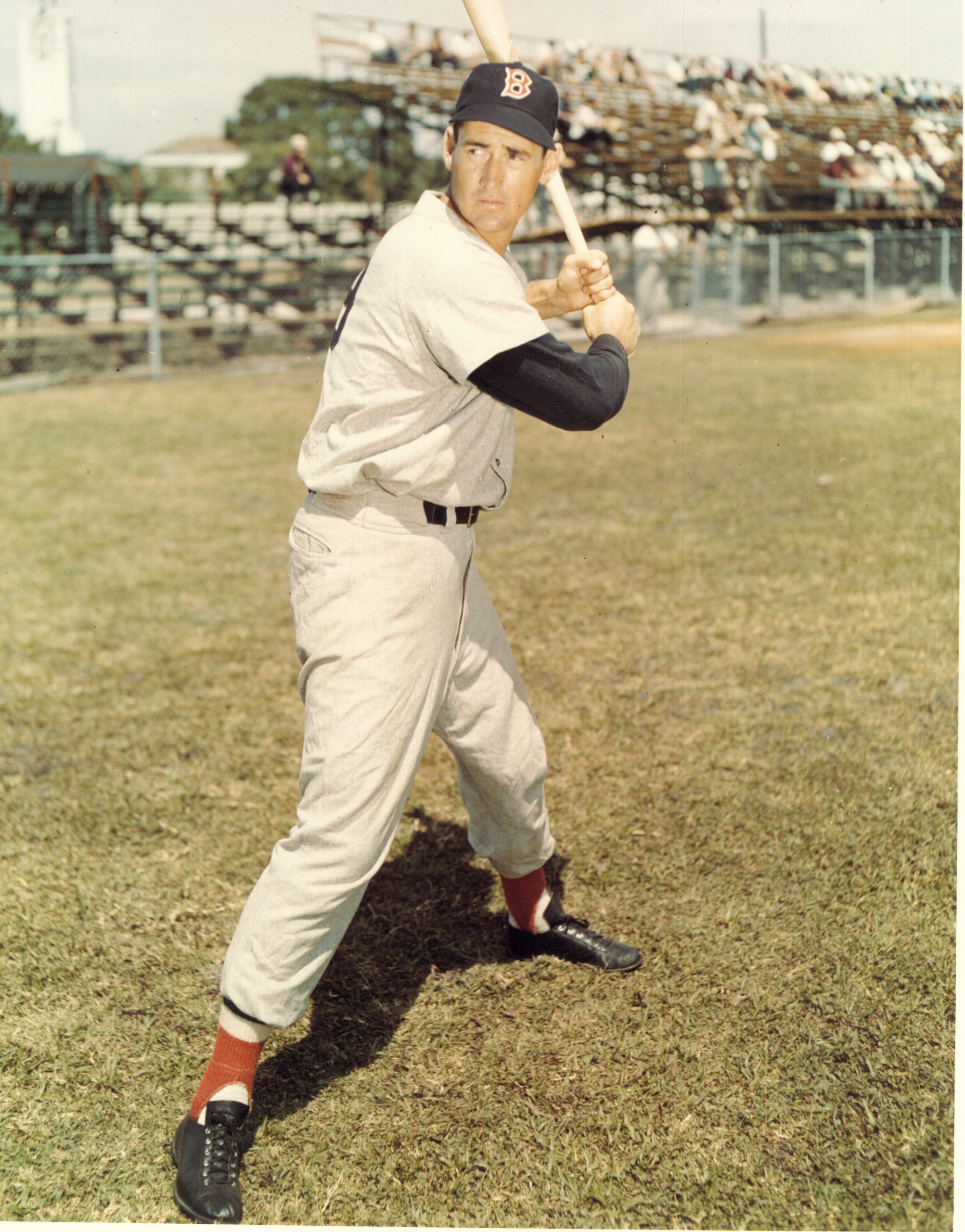
That was the official beginning of Theodore Samuel Williams’s relationship with the Boston Red Sox and major league baseball. It was an association that would last for over sixty years and an affiliation that would define the man and the sport. For all or parts of eight decades, Ted Williams was often the biggest story of spring training.
THE GREATEST HITTER WHO EVER LIVED
Ted Williams and Bobby Doerr were seventeen-year-old teammates on the 1936 San Diego Padres. Ted was a San Diego native who had grown up telling anyone who would listen, “When I walk down the street people are going to say, ‘There goes Ted Williams, the greatest hitter who ever lived.’” When Red Sox General Manager Eddie Collins traveled to the west coast to sign Doerr to a major league contract, young Ted Williams caught his eye and Collins negotiated an option on his contract with Padres’ owner Bill Lane.
In 1937, Doerr spent the year with the Red Sox, showing great promise, while Ted confirmed the wisdom of Collins’s judgment by pounding Pacific Coast League pitching. Eddie Collins asked Doerr to accompany Ted on the cross-country trip from California to spring training in 1938. Collins apparently recognized that the well-grounded Doerr would be a good balance for the exuberant Williams.
“Ted and I had trouble hooking up for the train trip because of heavy rains in California and throughout the south,” Doerr remembers. “I finally caught up with him in El Paso, Texas, and we took the train from there to Florida. I remember saying to Ted, ‘Wait until you see Jimmie Foxx hit the ball.’ His response was, ‘Wait until those guys see me hit the ball.’”
Asked if he had any inkling during that first trip that he and Ted would go on to Hall of Fame careers and a life-long friendship, Bobby Doerr laughs. “We were just a couple of teenagers who were serious about our baseball careers. And we both enjoyed going to the movies to watch westerns. The rest of it never occurred to me.”
In his autobiography My Turn at Bat, written with John Underwood (Simon & Schuster, 1969), Ted remembers his first visit to the locker room at old Payne Field to suit up for practice. “When I finally got into the dressing room in Sarasota, everybody else was on the field and Johnny Orlando, the clubhouse boy says, ‘Who are you? Ted Williams. Oh, well, The Kid has arrived, eh. You dress over there with the rookies, Kid.’” Ted Williams would retain his nickname of “The Kid” for the rest of his life.
A lot has been written about the ribbing Ted that took from his veteran teammates during this first training camp. Bobby Doerr didn’t remember it as being particularly vicious. “The veterans gave Ted a hard time. But all of the young players took some riding from the older players. That’s the way it was in those days. They were rough on him but it was mostly good-natured. And let me tell you, Ted gave it back as good as he got.”
Former Red Sox pitcher Charlie Wagner was Ted Williams’s first roommate and they continued to room together through Charlie’s final season with the team in 1946. Wagner remembered every detail of his first meeting with Ted.
“I was sitting in the clubhouse between Lefty Grove and Jimmy Foxx, right next to manager Joe Cronin’s office. Ted marched into Cronin’s office and asked in that big, booming voice of his, ‘Do you have anybody around here who doesn’t drink, doesn’t smoke, goes to bed early, and gets up early?’ Cronin pointed at me and said, ‘He’s sitting right there.’ Ted looked at me and said, ‘Will you be my roommate?’ I answered, ‘Of course I will.’ Ted said, “Good.’ And we roomed together for seven years and were friends for life.”
Ted showed a lot of promise during his first training camp but he learned that major league pitching was tougher than the Pacific Coast League. On March 21, the Red Sox optioned him to their farm club in Minneapolis. The proud Williams was crushed by his demotion. He told clubhouse attendant Johnny Orlando, “Someday I’m going to come back and earn more money than those three put together,” referring to regular Red Sox outfielders Joe Vosmik, Doc Cramer, and Ben Chapman.
Ted Williams may not have been prepared for the big leagues but he certainly was ready for the International League. In 1938 with the Minneapolis Millers he led the league with a batting average of .366, and finished second in the balloting for league MVP. Williams, who celebrated his twentieth birthday in August that season, also topped the league with 43 home runs and 142 RBI to earn his first Triple Crown.
FUTURE ALL-STAR
Bobby Doerr knew that Ted Williams would stick with the Red Sox following training camp in 1939. “We had traded Ben Chapman for Denny Galehouse, so there was an opening in the outfield. And after his great season in Minneapolis, everybody knew he was ready for the majors.”
Williams had spent the off-season in his hometown of San Diego. Ted and his long-time friend Les Cassie, Sr., started the 3,000-mile drive to Sarasota with plenty of time to arrive on schedule for camp. Unfortunately, Ted came down with a serious bout of the flu and the pair stopped for medical assistance in New Orleans, Louisiana. He arrived in Sarasota one week after the opening of camp, looking positively skeletal. “That’s when he picked up the nickname ‘The Splendid Splinter,’” Doerr reminisced. “Ted was really thin as a young man and when he arrived in camp right after getting over the flu, he was as thin as a rail. But it didn’t affect his hitting at all.”
Ted hit a game-winning home run in his first exhibition game that spring and continued in top form throughout the camp. He had yet to play a major league game, but already he was gaining a national reputation. The front page of the April 19, 1939, edition of The Sporting News featured a story on leading candidates for “rookie of the year.” The first name mentioned was Ted Williams, “The kid outfielder, who, in addition to being a great hitter, has the allure that goes with screwball tendencies.” The article concludes by nominating Williams and the Yankees’ Charlie Keller as the leading candidates for the honor.
When the 1939 regular season began, the greatest left fielder in Red Sox history took his place in the starting lineup: in right field. “He played behind me all season,” former All-Star second baseman Bobby Doerr recalls. “And the thing I remember best is how much the fans in the right field grandstand loved him. He would have a great at-bat, and when he ran back out to his position they would all stand up and cheer for him. Then he would take his hat, grab it by the button, and lift it as high over his head as he could. Everything changed later when he moved over to left field, but that season he tipped his hat as much as any player I ever saw.”
Ted Williams made The Sporting News prophecy look good, batting .327 and leading the American League with a rookie record 145 RBI. His 31 home runs served notice that he could hit with power to go along with a high batting average. The official Rookie of the Year Award hadn’t been created by 1939, but Ted was certainly the rookie sensation of that year.
The big stories in spring training in 1940 revolved around Ted Williams and the outfield. During the off-season, the Red Sox had added bullpens in right-center, and constructed new seating in right field to improve Ted’s home run chances at FenwayPark. The Boston press quickly dubbed the new area “Williamsburg”.
The other change was manager Joe Cronin’s plan to shift Ted from right to left field. On March 14, 1940, a front-page story in The Sporting News was headlined “Cronin Has His Mind on Williams’ Eyes.” The article pointed out that Babe Ruth played right field in Yankee Stadium because left field was the “sun field.” But he was shifted to left field on the road when the team played in parks where right was the sun field. The article concluded, “The better Williams gets, the more the Red Sox will benefit in many ways. So why keep him in the sun field if it is not necessary?”
Another reason to shift Ted from right field was the arrival of outstanding defensive outfielder Dominic DiMaggio. Dom joined the Red Sox from the San Francisco Seals in 1940 to begin a major league career that would span eleven seasons and include seven All-Star selections. It was also the beginning of a friendship with Ted Williams that would endure for over sixty years.
“I remember when they took me around the clubhouse to introduce me in spring training that Ted was very welcoming, very friendly” Dom recalled. “We had played against one another in the Pacific Coast League and he knew who I was.”
“I can remember during batting practice that spring we would crowd around the cage to watch him hit. It reminded me of an incident that took place in 1937, when he was playing for San Diego. Our manager, Lefty O’Doul went over to speak to Ted. That never happened in those days. When Lefty got back to the bench we all wanted to know what he said. ‘I told him, whatever you do, don’t ever let anybody change that swing of yours.’”
THE LAST .400 HITTER
By the standards applied to a mere mortal, Ted Williams’s second season with the Red Sox would be judged a tremendous success. In 1940 he raised his batting average 17 points to .344, good enough for third place in the American League. But the Boston press and Red Sox fans held Ted to a higher standard. His home run total dropped from 31 to 23 despite the easier target in right field, and Ted came in for his first round of criticism. Always thin-skinned, he told a Cleveland newspaper writer that he would rather be a fireman than a baseball player. 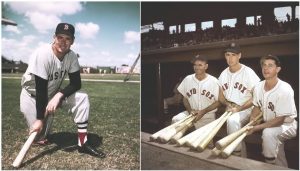
For the second year in a row, Ted spent the off-season in Minneapolis to be near friends he had made during his season with the Millers. He enjoyed the hunting and fishing and it gave him a chance to be near his future wife, Doris Soule. But when the first day of spring training arrived, Ted was nowhere to be found.
Ted was not pleased with the contract that the Red Sox had sent him for 1941 and he had not responded to the team. On March 1, 1941, baseball writer Mel Webb updated fans on Ted’s whereabouts with this item in The Boston Globe: “There’s no more news about Williams except the Red Sox now know that he is in the land of the living. Also, he wants to talk things over with Eddie Collins.”
Ted quickly reached agreement with the Red Sox but he arrived at training camp one week late. James C. O’Leary described Ted’s arrival for Globe readers: “Ted Williams, the hard-hitting outfielder of the Red Sox, arrived in camp last night after a 1,600 mile drive over the road from Minneapolis. It was a hard trip through snow; hail and rain from start to finish.”
“I’m perfectly satisfied,” Williams told reporters, “and am well pleased to be back to work. You may be sure that I will do my best to show my appreciation, and that’s all I can do.”
Ted quickly got in shape and appeared to be in regular season form until he injured his ankle in an exhibition game on March 19. He was treated for a sprained ankle, but X-rays taken during a stopover in Birmingham, Alabama, revealed that he had a chipped anklebone.
Bobby Doerr has an interesting theory on the affect the ankle injury had on Ted’s hitting. “Ted didn’t play much early in 1941, but he adjusted quickly and got back in the lineup. I watched him closely that year and I was sure that he was waiting on the pitch until the very last second because he was conscious of his ankle. It was probably his best year and I really thought he waited on the pitch better than he ever had.”
Clearly Ted did most things right in 1941. While the baseball world focused on Joe DiMaggio’s 56-game hitting streak, Williams quietly crept over .400 and stayed there until the next-to-last day of the season. Williams brought a .39955 average into a doubleheader against the Philadelphia Athletics. He managed six hits in eight at-bats for the two games to finish at .406. Ted had become the first American Leaguer to finish over .400 since Harry Heilmann had batted .403 for the Detroit Tigers in 1923.
A new face was added to the Red Sox roster for spring training in 1942: shortstop Johnny Pesky. But Johnny was no stranger to Ted, Bobby Doerr, and Dom DiMaggio. All three of them had met Pesky years earlier when he was the visiting clubhouse assistant for Portland in the Pacific Coast League.
Johnny Pesky never forgot the first time he met Ted Williams as a Red Sox teammate. “I was having dinner with Bobby Doerr in the dining room of the Sarasota Terrace Hotel. Bobby and I had finished dinner and we were talking and all of a sudden Ted appeared. He sat down and started talking to Bobby. I was kind of in awe. Here I was a rookie sitting with Ted Williams, who hit .406 the year before.
“Eventually he turned to me and said in his great, booming voice, ‘Are you the kid from Louisville?’ I told him that I was, and he said, ‘If you can hit .280 you’ll help us.’ I told him that I could run .280, and Ted kind of laughed. I got to know Ted, Bobby and Dom that spring and we stayed friends for all these years. Ted and Bobby are in the Hall of Fame, of course, and Dominic should be. Me? I just sort of tagged along with the three of them.”
The four teammates would remain fast friends for sixty years. Their relationship is wonderfully captured in David Halberstam’s The Teammates (Hyperion, 2003).
WORLD WAR II
There was a cloud hanging over spring training for all major league teams in 1942. Pearl Harbor had preceded the opening of camp by less than three months. A number of big leaguers were already in the armed services including Cleveland’s Bob Feller and the Tiger’s Hank Greenberg. Ted’s draft status had been reclassified as 3A since he was the sole support of his mother back in San Diego, but the nation was clearly gearing up for the war effort.
Charlie Wagner remembers talking with Ted about enlisting in the armed services. “It was on both our minds. We both wanted to do the right thing. We knew we were going to enlist. The only question was when.”
Ted played in 150 games in 1942, enlisting in the Navy Air Corps during that season with a delayed reporting date. He also took night school aviation classes on a regular basis while the season was in progress. Ted won the first of his two American League Triple Crowns in 1942, and registered a league-leading on-base percentage of .499.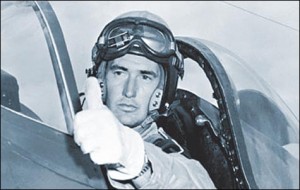
When spring training camps opened in 1943, Ted was in preflight training in Chapel Hill. In 1944, Ted was in Florida, but it was Pensacola for advanced flight training. After his training was completed, Ted married his first wife, Doris Soule, whom he had met during his 1938 season with the Minneapolis Millers. Following his advanced training, Williams was stationed in Jacksonville, Florida, where he was being readied for combat while spring training took place in 1945. He was in San Francisco, en route to assignment in the Pacific Theatre, when World War II came to an end.
AMERICAN LEAGUE CHAMPIONS
Spring training camp in 1946 held a special place in Johnny Pesky’s heart. “The war was over and you got to see guys you hadn’t seen for three years. We had all been in the service and you had some concerns for one another. It was like a reunion, we were so happy to see one another. And we knew we had a great team that year.
“Ted had hardly held a bat in his hand for three years, but when he stepped into the batting cage for the first time, you could see that his swing was exactly the same. Sure, he had to get his timing back, but from the first swing you could see he hadn’t lost a thing. Ted had that great, graceful swing and he picked up right where he had left off.”
Charlie Wagner remembers seeing his old roommate for the first time in three years. “It was so great to see him. He said, ‘Are you going to try me again?’ I told him of course I was. And we picked back up like there had never been a break.”
Questioned about stories that he had asked the Red Sox to find him a new roommate early in his career because Ted wouldn’t stop talking about hitting, Charlie Wagner chuckles.
“Those stories just aren’t true. We always got along great. But I’ll tell you another funny story. Ted got a new shipment of Louisville Sluggers. We’re in our room, and I’m lying down on an old four-poster bed. Ted is looking in the mirror, getting a feel for his new bat. He takes a swing, whacks the bed with his bat and the whole thing collapses. Ted looks at the bed lying on the floor, and all he said was, ‘Call downstairs and have them send up a new bed. I’ve got to get some more of these bats. They’re great.’
“Ted was just a terrific fellow. I remember one time we were having breakfast and a woman came over to our table with her ten-year old son looking for Ted to give him some batting tips. Ted rolls up his newspaper and tells the youngster to take a swing. Ted says, ‘That’s not much of a swing. Remember, you have to go back before you go forward. Take a good swing, don’t push the ball’ and the kid went off beaming with a good batting tip from the great Ted Williams.”
Spring training in 1946 included a trip to Cuba to play a series of exhibition games against the Washington Senators. In My Turn at Bat, Ted recalled his outfield adventures in one game. “I remember we played in a nice little park in Havana where the outfield sloped up, the main part of the field was down in a gully, and early in the game I came running down the slope to catch a fly ball and I dropped it. In Latin America they don’t boo you for a bad play, they whistle, and I heard those whistles for the first time. It was a new thrill. I had been blasted by experts in every imaginable way. This was art in a new form.”
In 1946 the Red Sox jumped out ahead of the field in the American League and clinched the pennant in mid-September. Ted led the league in runs scored and total bases, and he was named the American League’s Most Valuable Player. But the Red Sox lost a heart-breaking, seven game World Series to the St. Louis Cardinals as Ted batted a disappointing .200, with only five singles. It would turn out to be his only World Series appearance.
THE LATE 1940s
Sam Mele, who played the outfield for the Red Sox and spent over thirty years with the team as a scout and roving instructor, was a rookie in 1947. “For some reason Ted took a liking to me. He wanted me to sit next to him on all the bus rides we took to exhibition games that spring and talk hitting. He used to say, ‘Come on, Meal. Let’s go.’
“And he would talk hitting the whole ride. ‘Look for this. Look for that.’ And he would quiz me about what I would do in a certain situation. When you finally got off the bus you thought you were the greatest hitter in the whole world.”
Ted led the American League in batting average, home runs, and RBI in 1947, earning his second Triple Crown. He also led the league in runs scored, walks, slugging average, and extra base hits. He finished second in the balloting for the league’s Most Valuable Player.
The big story of the 1948 spring training camp was the arrival of new manager Joe McCarthy. Long-time Red Sox manager Joe Cronin had moved up to General Manager and McCarthy, who had led the New York Yankees to seven American League pennants, was hired to get the Red Sox back to the World Series. 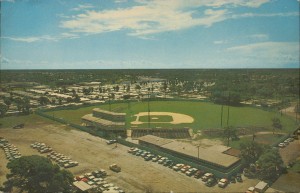
Joe McCarthy was known as a stern disciplinarian and a stickler for formal team rules. The Boston sportswriters, who feasted on any controversy involving Ted Williams, had a field day speculating on their potential clash.
McCarthy, who was well aware of Ted’s disdain for neckties, deflated the controversy by appearing for breakfast at the team’s headquarters in the Sarasota Terrace Hotel in an open sports shirt. Asked if he thought he would clash with Williams, he answered, “I wouldn’t be much of a manager if I couldn’t get along with a .400 hitter, now would I?”
Johnny Pesky still marvels at Ted’s dedication to hitting. “We would be playing in an exhibition game, and Ted would be up and down the dugout asking for insight on the pitcher. We would play a lot of National League clubs, pitchers we wouldn’t ordinarily see, and he’d be saying, ‘Who do we see in our league who reminds you of this guy? Where’s his release point?’ These were just exhibition games, but Ted would approach them just the way he would a regular season game.”
Sam Mele laughs when he recalls the only time Ted Williams ever invited him fishing. “We would get a few days off during spring training, and this one time Ted invited me to come along on a fishing trip. I remember Mickey Harris (Red Sox pitcher) was along, and when we got out there I was seasick. I mean I was really seasick. We had to go back to shore to get me something to settle my stomach. I caught a twelve-foot king mackerel fish, the biggest fish we caught all day. I don’t know if Ted was madder because I got seasick or because I caught the biggest fish. All I know is he never invited me fishing again.
“He worked harder than any player I ever saw. He had all sorts of contraptions he had rigged to build up the strength in his forearms. But he did love his fishing. I remember one time Joe McCarthy said to him, ‘Ted, I wish some day you would catch a whale so you will stop talking about fishing.’”
The 1948 Red Sox tied Cleveland for first place in the American League but lost the one-game playoff game to the Indians at FenwayPark. Ted led the American League in batting with a .369 average that year, and he also led the league in on-base percentage and slugging average.
When spring training began in 1949, Ted’s career batting average stood at .354. Only three players in major league history have ended their careers with a higher lifetime average: Ty Cobb, Rogers Hornsby, and Shoeless Joe Jackson.
Former Red Sox pitcher Mel Parnell has a very strong recollection of the first time he met Ted Williams. Parnell, who would go on to win more games in a Red Sox uniform than any other left-handed pitcher, remembers, “I was in the outfield and somebody introduced us. I was amazed and tongue-tied. I couldn’t believe I was actually meeting the great Ted Williams. I managed to mumble something, and later we became great friends, but that first day I was just overwhelmed and practically speechless.”
Mel remembers pitching batting practice to Ted in spring training. “I pitched a lot of batting practice to Ted over the years. He didn’t face many lefties at FenwayPark, so he wanted me to pitch to him like it was game conditions. I liked it, because I knew if I could figure out how to pitch to the great Ted Williams, I could pitch to anyone.”
The 1949 season was a disappointing one for Ted and his Red Sox teammates. The Red Sox held a one-game lead in the American League standings with two games to be played at Yankee Stadium to end the season. The Yankees swept both games and the Red Sox season was over. Williams led the American League in ten major batting categories, and he was voted the Most Valuable Player in the American League, but a shot at another World Series appearance had eluded him.
THE EARLY 1950s
When training camp opened in 1950, Ted Williams, Bobby Doerr, Dom DiMaggio, and Johnny Pesky had formed the nucleus of the Red Sox for five full seasons. “We had some great teams those years,” Johnny Pesky recalls. “We felt like we were the best team most of those years, but something always prevented us from winning it all. But we really looked forward to spring training that year. We knew we wouldn’t stay together forever.”
Ted Williams was at the height of his career that spring. “The Kid” was thirty-one years old when training camp began in 1950. He took spring training very seriously, and in My Turn at Bat, he describes his approach to the pre-season. “You start seeing the ball, really ripping it, within two to three weeks, but you need four to five to be really sharp. Maybe not at age twenty-two, but certainly at age thirty-one. Spring training does that for you. You can’t just tape up an injury like they do in football and go out on the field. It’s too exacting a game.”
Mel Parnell looked forward to seeing Ted each year when spring training rolled around. “I remember him for the great hitter he was, but also because he was a wonderful teammate. He knew that if he stayed at the hotel with the rest of us, he wouldn’t get a moments peace, so by that time he was living in an apartment by himself. We all understood that. But you couldn’t ask for a better teammate in the clubhouse or on the field.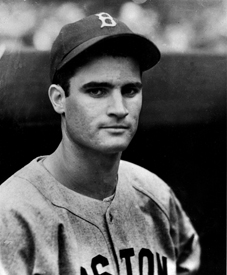
“He was a different guy when he was just with his teammates. He was loud, and he could be profane, but mostly he was just fun to be around. He was different around the writers, but with his teammates he was real good-natured, almost happy-go-lucky.”
Ted suffered his first serious injury at the All-Star Game in Chicago that year. He made a nice catch against the wall on a long drive hit by Ralph Kiner, but he broke thirteen bone chips in his left elbow in the process. Ted returned to the starting lineup in mid-August, but the Red Sox drive for the pennant ran out of gas in the last week of the season. Ted appeared in only eighty-nine games that season and his batting average of .317 was his career-low to that point.
Training camp in 1951 would be the last spring that Ted, Bobby, Dom and Johnny would all be together. Ted liked to refer to his three pals as, “My guys.” But Bobby Doerr’s back was beginning to be a chronic problem. It would ultimately result in his premature retirement at age thirty-three following the 1951 season.
“Ted was such a smart hitter,” Bobby Doerr remembers. “When he was in spring training he would use a thirty-four ounce bat. That’s a pretty big bat, but Ted could handle it real well. When it got late in the season he would shift to a lighter bat and not miss a step.”
Ted had another concern as he rounded into shape that spring training. In My Turn at Bat, he describes his elbow surgery after the All-Star Game and the prognosis at the time. “Doc Fadden (Red Sox trainer) told me later that neither doctor held out much hope for a complete recovery. One of them wanted to take the whole tip out, the radius. The other held out for the thirteen bones chips I’d broken off the bone. He said, ‘Leave as much of the radius in as possible, this guy’s a ballplayer, it’s his only chance.’”
Ted had asked manager Steve O’Neill to limit his appearances in spring training games to give his elbow a chance to heal fully. But O’Neill, in an apparent effort to show who was in charge, played Ted in almost every game. The Splendid Splinter was not pleased.
Ted batted only .318 in 1951, but this was the fourth highest batting average in the American League. He finished first in the league in slugging average, walks, and on-base average.
CAPTAIN WILLIAMS, U.S.M.C.
Ted Williams reported on time for spring training in 1952, but getting in shape for the upcoming season was not his greatest concern. In January he had been notified that the U.S. Marine Corps would call him to active service in May. Ted had remained in the Marine Corps Reserve following World War II, and with hostilities heating up in Korea, the Marines were recalling 1,000 pilots.
Ted expressed mixed feelings about the handling of the conflict in Korea, and he questioned the fortitude of politicians. But he wrote in My Turn at Bat, “I was bitter about it, but I made up my mind that I wasn’t going to bellyache about it.” He would serve his country as he had in World War II. 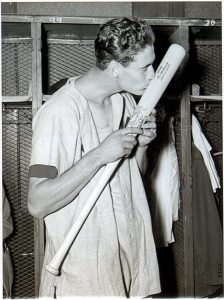
Mel Parnell remembers the spring of 1952 as a tough time for Ted. “We all felt badly for him. He had already lost three years to World War II. But any time you wanted to find Ted Williams at night during spring training, you could go out and look on one of those bridges in Sarasota. He was on one of those bridges fishing somewhere. He was a master. He could tell you what the fish was doing in the water before it took your bait.”
Ted made every effort to get into regular season shape in Sarasota because there was a possibility that his elbow injury would disqualify him from active military duty. After a cursory examination of his elbow, Marine doctors cleared Ted for service as a fighter pilot. He would play in only six games in April before his return to active duty.
Red Sox and Boston city officials declared April 30, 1952, as Ted Williams Day. Ted told the crowd of 25,000, “This is a day I’ll always remember, and I want to thank you, fans, in particular, from the bottom of my heart.” In what many thought would be his last at-bat in the major leagues, Ted Williams homered into the right-field grandstand.
When the Boston Red Sox reported for spring training in 1953, Captain Ted Williams, U.S.M.C., was 8,000 miles away serving as a combat pilot in Pohang, South Korea. Charlie Wagner later spoke to John Glenn, former astronaut and US Senator, who had flown with Williams in Korea. “John Glenn told me that Ted was as good a pilot as he ever saw. He said that very few pilots could have landed a flaming jet the way that Ted did and walk away from it. He flew 39 missions over there. It was a remarkable record.”
The U.S. Marine Corps discharged Ted in July of 1953, about two months shy of his thirty-fifth birthday. He signed a contract with the Red Sox for the balance of the season in late July and established his own training regimen to get himself in shape. Whatever he did certainly worked since he batted .407 in 37 late season games. It was said that he had set back Spring Training by about ten years.
THE SHORTEST SPRING TRAINING
Spring training in 1954 would last less than one hour for Ted Williams. In his book, Ted Williams: ‘Hey Kid, just get the ball over the plate!’ former Red Sox pitcher Russ Kemmerer describes Ted’s arrival at camp that year.
“Spring training in 1954 began with high expectations; a sense of excitement prevailed. Williams’ return and the changes in personnel gave a new look to the club. However, destiny often steps in to alter a team’s course, as it did one morning during batting practice. Williams had just taken his turn in the batting cage, and then pranced out to his position in left field to shag a few balls.
A low line drive was hit in his direction. He attempted a shoestring catch. Suddenly, he tripped and lunged forward, falling on his shoulder as he hit the ground. Pop! “I think I broke my collarbone!” he exclaimed. He slowly raised himself from the turf and headed for the clubhouse. Trainer Jack Fadden confirmed the break. The injury changed the direction the Red Sox would take, and stalled, at least for the time being, the drive to the top of the standings.”
After surgery to insert a four-inch, stainless steel pin, Ted worked out at FenwayPark to salvage what was left of the 1954 season. He returned to action in May, playing in 117 games while compiling a batting average of .345. But the combination of injuries and personal issues led Ted to announce that he would retire at the end of the season. In what was expected to be his final at-at in his final game, Ted homered into the right-field grandstand in FenwayPark.
When spring training rolled around in 1955, Ted was in the Florida Keys fishing. On Opening Day at FenwayPark, Ted was still fishing. Eventually, the combination of inactivity and financial pressures resulted in a change of heart. On May 13, two days after his divorce from his first wife Doris was final, Ted returned to Boston and signed a contract covering the balance of the 1955 season.
By this time, Ted had mastered the art of individual conditioning. He returned to the lineup in late May and picked up right where he had left off, batting .356 for the season. Despite playing in only ninety-eight games, he finished third in the American League with twenty-eight home runs for the season.
THE LATE 1950s
When Ted Williams arrived at training camp in 1956, he was thirty-seven years old and he had played in all, or parts, of fourteen major league seasons. By this time Bobby Doerr, Dom DiMaggio, and Johnny Pesky had all retired as active players. Mel Parnell was one of the few players remaining from the great Red Sox teams of the late 1940s.
“I always looked forward to seeing Ted at spring training,” Mel reflects from his home in New Orleans, Louisiana. “As a player, you always looked forward to spring training and seeing all of the players, but seeing Ted was special. He was a wonderful teammate.
“He and I would talk hitting all the time. As a pitcher, it was a big help to me. He was always very generous with his knowledge of hitting, sometimes to a fault from the pitcher’s point of view. We would see him giving advice to a hitter from another team and we would just shake our heads. But he would help anyone who asked him.”
Ted Williams had an outstanding season in 1956. His batting average of .345 ranked second in the American League and his on-base average of .479 led the league. Best of all, he stayed reasonably healthy and appeared in 132 games, his highest level since 1951.
Spring training in 1957 was a special time for Ted Williams. Recognizing the value of their best hitter, the Red Sox allowed Ted to set his own schedule. He didn’t appear in an exhibition game until March 17.
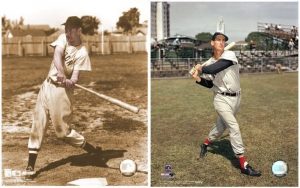 Spring training in 1957 was also a special time for former Red Sox third baseman Frank Malzone. The eight-time American League All-Star followed training camp with an outstanding season, earning a Gold Glove as the best fielding third baseman in the American League. “I remember the first time I met Ted in spring training. I had been in the service and I had played a lot of ball in Hawaii. Ted was one of the first players to greet me. He said, ‘I know who you are. I heard you were playing some great ball in Hawaii. You’re really going to help us.’ I thought to myself that this is a great guy. He goes out of his way to meet me, and he knows who I am.”
Spring training in 1957 was also a special time for former Red Sox third baseman Frank Malzone. The eight-time American League All-Star followed training camp with an outstanding season, earning a Gold Glove as the best fielding third baseman in the American League. “I remember the first time I met Ted in spring training. I had been in the service and I had played a lot of ball in Hawaii. Ted was one of the first players to greet me. He said, ‘I know who you are. I heard you were playing some great ball in Hawaii. You’re really going to help us.’ I thought to myself that this is a great guy. He goes out of his way to meet me, and he knows who I am.”
THE KID HITS .388
The 1957 regular season was one of Ted’s best seasons in the big leagues. He batted .388 in 132 games, his second highest average for a full season. If five more of his line drives had fallen in for hits, he would have batted an even .400 for the season. No one had achieved the .400 mark since his .406 average in 1941, and no one has reached it since. But at age 39, Ted came as close as anyone.
March 1958 was the twentieth anniversary of Ted Williams’s first spring training camp in Sarasota with the Red Sox. He had come to camp as a teenager and now he was approaching his fortieth birthday in August. During his sixteen seasons he had been named to fourteen American League All-Star teams, he had led the league in batting average five times, and he had been named the Most Valuable Player in the American League twice. He had become a legend in the game.
“Ted was always the biggest story in spring training,” Frank Malzone remembers. “All of us listened to every word he said about hitting. And during batting practice the players from other teams, especially the National League teams who never got to see Ted hit, would crowd around the batting cage to watch him hit. You would see the biggest stars in the game standing around like little kids. You could see how impressed they were.”
Former Red Sox pitcher Bill Monbouquette grew up in Medford, Massachusetts, and watched Ted as a fan in the late 1940s and early 1950s. “Ted was the biggest sports star in Boston. Growing up in Boston, you read about him all the time and every kid on the playground wanted to be Ted Williams when they grew up. I still remember the first time I met him in spring training. I was introduced to him, and he said, ‘I know this guy. He can throw strikes.’ When I signed with the team as a kid, I hung around Fenway and pitched batting practice until I was assigned to a minor league team. I was so happy that he remembered me in a good way.” 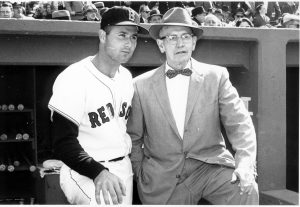
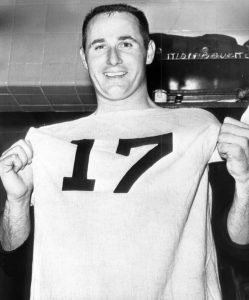
Ted turned forty on August 20, 1958, and he celebrated in September by winning his sixth American League batting title, edging out teammate Pete Runnels with a .328 average. Veteran sports writer Harold Kaese wrote in The Boston Globe, “Aladdin had his wonderful lamp, King Arthur had Excalibur. Ted Williams has his bat. If you are given a choice, take the bat. It is the magic wand of the century.”
Spring training in 1959 required a major adjustment for Ted Williams. After nearly twenty years of training in Sarasota, Florida, he reported to the new Red Sox training camp in Arizona. Payne Field in Sarasota was beginning to show its age and the Red Sox elected to move 2,500 miles west to the then-sleepy little town of Scottsdale, Arizona.
“I remember playing golf with Ted out in Scottsdale,” Frank Malzone reminisces. “I think he played more golf out there because he couldn’t go fishing. He was a pretty good golfer, but not a great one. I remember I was paired up with Lu Clinton (former Red Sox outfielder) who was a terrific golfer. Ted was playing with Dick Stuart (former Red Sox first baseman, commonly known as “Dr. Strangeglove”), who could hit the ball a mile. After about ten holes, we were beating them really badly. Ted turned to Stuart and said, ‘I thought you could play this game.’” 
Ted’s biggest problem in spring training in 1959 was a neck injury. Ted wrote in My Turn at Bat, “I was at my home in the Florida Keys, telling an old friend what I thought I was going to do that season, how good I felt. I got up and started swinging the bat. I didn’t realize it then, but I hurt my neck that day. I’m sure of it.”
His spring training was cut short when the Red Sox sent him to the Lahey Clinic in Boston for treatment. Bothered by his neck injury throughout the regular season, Ted had his worst season in the major leagues, batting an embarrassing .254. Long-time Red Sox owner Tom Yawkey, who had been extremely close to Ted throughout his career, tried to convince Ted to retire. Yawkey felt that the years had caught up with Ted, and that playing at a diminished level would detract from his legacy.
THE LAST AT BAT
But Ted Williams was convinced that he had one more All-Star caliber year left. He was determined to finish his career on a high note, not with a .254 batting average. Remembering spring training in 1960, the forty-one year old Williams wrote, “I felt good that spring. Not The Kid from San Diego any more, all full of spit and vinegar, but not old either.”
When Bill Monbouquette thinks back to that spring he remembers Ted’s good spirits. “He was full of energy that year. We would horse around in the outfield during batting practice. You could tell he was enthusiastic about his last year. What I remember most was playing against the San Francisco Giants and seeing Willie Mays and Willie McCovey, future Hall of Famers, and great hitters like the Alou brothers, all crowded around the batting cage. They couldn’t wait to see Ted hit.
“Ted was a great teammate. He was loud, he had that great booming voice, and I think he intimidated a lot of the writers. But you couldn’t ask for a better teammate. He was my friend, but I was in awe of him. I’m still in awe when I think about him.”
It is fair to say of the 1960 season that Ted went out in a blaze of glory. One of only a handful of players whose career spanned four decades, he hit home run number 512 in August to move into third place in career home runs, trailing only Babe Ruth and his former Red Sox teammate Jimmie Foxx. His batting average for the season was .318 in a year when teammate Pete Runnels won the American League batting title with a .320 average.
On September 26, 1960, the Red Sox announced that Ted would retire at the end of the season. His last major league game was at FenwayPark on September 28 against the Baltimore Orioles. Twice before, first when Ted was headed to combat duty in Korea and in 1954 after he had prematurely announced his retirement, Ted had homered in what was scheduled to be his last at-bat in the major leagues. In the eighth inning, in what would truly be his last at-bat, with the count 1-1, Ted drove a pitch from Jack Fisher deep into right-center field. The drive cleared the fence, struck the canopy over the bullpen seating area, and came to rest in the bullpen for career home run number 521.
SPRING TRAINING 2016
Ted Williams’s lifetime batting average of .344 ranks sixth among all modern day players in major league history, and his lifetime on-base percentage of .482 is the highest ever achieved by a major leaguer. He was inducted into baseball’s Hall of Fame in 1966, and his acceptance speech was the catalyst for recognition of the stars of the Negro Leagues by the Hall of Fame. More than fifty years later, Ted still ranks either first or second on eleven categories of the Red Sox all-time career batting leaders list.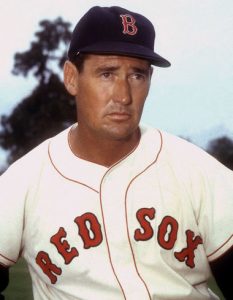
Most Red Sox fans under the age of sixty-five never had the great pleasure of watching Ted Williams bat in person. If they had been able to see him play in only one game, they probably would have seen him get a base hit. Ted had 2,654 hits in 2,292 games.
But as impressive as his numbers are, Ted was a lot more than statistics. If they could have seen him stride to home plate just one time, they would have heard the same crowd murmur that accompanied Frank Sinatra’s stage entrance, or the start of a Bobby Orr rink-length dash at the BostonGarden. And most importantly, they would have seen one of the greatest hitter who ever lived.
Portions of this article appeared in various editions of Red Sox Magazine. To subscribe to Red Sox Magazine click here.


Herb,
Great story on Ted Williams. We were lucky to see Ted play at Fenway when your mother took a group of us. That was my first Major League game, and I remember the Sox won. Is my memory right?
Your memory is 100% accurate Jim!
Thanks for your kind words.
Great story about Teddy Ballgame. I can never read too much about Ted Williams. He has always been my favorite professional player and favorite Red Sox, ever !! The greatest. Yaz ranks pretty high as does Johnny Pesky, Bobby Doerr, Jim Rice, Big Papi, and a few others but there will never be another Ted Williams.
Nice job, Herb.
Great job, Herb! My brother lived baseball. I inherited all his memorabilia. He would have loved this story of Ted Williams.
Great story about one of my favorite men, written by one of my favorite men. Thanks, Herb! Love your writing!
A sincere thank you to one of my favorite ladies!
A really great article. I didn’t have the priviledge to see Ted Williams play in person, but I have always been an admirer. I can never get enough of stories or information about him. This article just added to my knowledge of the great hitter. Boy, how envious I am of those that got to watch his great career.
I also never knew that he had hit those other two homers, in what may have been his last at bats prior to 1960. He was going out with a home run whether anyone liked it or not! HA!
I started following Baseball in 1959 after attending a Dodger game in LA….I remember reading about Ted then as I read every article I could find in the LA Times and the San Bernardino Sun….he was unbelievable as a hitter, and from what I’ve read, quite the teammate….great article! Thanks
And I thought we’d just sit in the stands………
In the spring (March 31st) of 1957 the Boston Red Sox had a scheduled exhibition game with the New Orleans Pelicans. This was my chance to see the greatest baseball hitter who ever lived.
Williams hit 406 in 1941. On that ’41 team was a player by the name of Al Flair who grew up in New Orleans. I knew Al Flair, so I called Al and said “I sure would like to see Ted Williams”. Al said, “come on over and I will take you to the game”. Al Flair took me to Pelican Stadium. He pulled right into the stadium lot and I just followed Al without any
tickets to the game into the stadium and directly into the tunnel to the third base Red Sox dugout.
Williams was wearing a heavy rubber lined baseball uniform trying to lose some weight. He was laughing and joking with all of the Red Sox players. When he saw Al he came into the dugout and sat down next to Al. I said to Al “please be sure to ask Ted to autograph a baseball for me”. He said sure and with that Williams got a new baseball and signed it there in the 3rd base dugout and handed it to me.
I was thrilled and have remained overwhelmed now 60 years later. I met Ted Williams, the greatest hitter who ever lived.
Ted Williams was 39 when the season ended, leading the American league with an average of 388. With younger legs, that season BA would have been 400+.
Ray S. Cook
Thank you for the great article on my boyhood idol. I’m curious about the last photo you used in the article, the close-up of Ted in uniform. Can you tell me the history of that photo: who took it and where it first appeared? I’d like to know because I have the 4 color printing plates for that photo.
Thank you, Nik Outchcunis
And don’t forget, The Kid was not only put in Baseball’s Hall of Fame, but he also was elected to the IFGA Fishing Hall of Fame. Not only was Ted the greatest hitter of all time, but he was also one of the greatest fishermen of all time.
And… John Glenn thought him a great pilot/wing as too!
I watched Ted on tv in NH growing up. Followed his exploits faithfully. An inspiration to any aspiring young baseball player. Baseball was not my calling, skiing was yet I am still a lifetime Ted Williams fan. The biggest thrill I had was watching his final at bat with the hr over the bullpen. I was sitting in the furthest seat in the bleachers closest to left field and no one could have gotten closer to the field. Thank you for wonderful memories…